 MKh-6411 Mass Spectrometer
MKh-6411 Mass Spectrometer
|
 Mass Spec. Intake System
Mass Spec. Intake System
|
|
Three experiments were designed to analyze the chemical makeup of the atmosphere and clouds. Seen above, a radio-frequency
mass spectrometer had a complex meter-long intake system to avoid becoming contaminated by cloud material as Venera-9's spectrometer had.
Instead of admitting gas through a microscopic opening, it used an inlet valve that opened a large area for an extremely short time interval.
And finally, it would not activate until far below the cloud and sub-cloud haze layer.
A gas chromatograph measured chemical abundance in a completely different manner, by varying rates of diffusion through carefully chosen porous materials. The third chemical analysis experiment would collect cloud material in a filter and measure the spectrum of X-ray induced fluorescence. The spacecraft bus contained instruments geared for deep space and Venus flyby encounter:

Flight Plan of Venera-11 Both weighing 4450 kilograms, Venera-11 and 12 were launched in 1978 on September 9 and 14. This launch window was a poor opportunity to orbit Venus, because the vehicles would arrive with three times the kinetic energy that Venera-9 and 10 did. Instead, hyperbolic trajectories and precise timing permitted sufficiently long radio links after landing. The Venera-12 arrived on December 21, and Venera-11 arrived on December 25. To make more room for cloud-analysis experiments, the parachute system was reduced to just a pilot chute, a supersonic braking chute, and a single descent chute which was jettisoned at the bottom of the cloud layer (49 km). As the atmosphere thickened with depth, the craft slowed from 50 meters/sec (112 mph) to a landing speed of 8 meters/sec (18 mph). Descent took 1 hour. Venera-12's landing raised a cloud of dust which darkened the sky for 20-30 seconds, until 1 meter/sec winds cleared it away. At Venera-11's site, no dust was observed. Venera-11 landed at 14° S 299° E. Conditions there were 92.6 atmospheres of pressure and a temperature of 452° C (846° F). It remained in radio contact for 95 minutes, until the bus vehicle moved out of range. Venera-12 landed about 850 km from there, at 7° S 294°, finding 93.6 atm and 468° C. It transmitted data to Earth for 110 minutes.
The new atmospheric experiments provided information on important trace gases. The x-ray fluorospectrometer found chlorine to be ten times more common than sulphur in cloud material. This was interpreted to mean that the clouds contained a nonvolatile chlorine compound. Aluminum chloride was one speculation at the time. Unfortunately, the mass spectrometer on the Pioneer large probe became clogged by cloud droplets, but its gas chromatograph gave similar results to Venera, except for a much higher water content.

Burst of Electrical Activity Detected by Venera-12 The GROZA experiment detected bursts of low-frequency radio noise similar to those generated by lightening storms on Earth, but significantly more intense. There is some evidence that they originate in the deep atmosphere, far below the cloud layer. Lightning strikes around volcanic eruptions or some unknown atmospheric electrical phenomena could be responsible. It detected intense electrical activity during the descent of Venera-11, but much less from Venera-12, indicating that thunderstorms may be localized events on Venus as on Earth. |
 360° Radiation Intensity (33 km)
360° Radiation Intensity (33 km)
|
 Sky Spectra by Altitude
Sky Spectra by Altitude
|
|
Venera-11 provided detailed information about the spectral and spatial distribution of light during its descent. The 360°
photometer measured four wavelengths corresponding to green, red and two infrared ranges.
Scattering causes the sky to become increasingly orange (approximately the color of the text chosen for these pages).
In red and infrared, absorption lines for water and carbon dioxide are evident.
Looking down from a great height more blue wavelengths and little infrared is backscattered.
Because of Rayleigh scattering in the dense lower atmosphere, seeing conditions are poor, even though the atmosphere is clear of aerosol particles. The surface would not be clearly visible more than a few kilometers above it. An observer standing on the surface would see the rocky terrain fade into the featureless orange haze of the sky. The cloud layer would not be visible, except as diffuse changing regions of lighter and darker illumination in the sky. Bandwidth from the lander was increased by a factor of 12 for this mission, and the relaying fly-by module used the new 70-meter radiotelescope in Evpatoriia, Crimea. This was particularly necessary because of the new camera system. A Venera-9 camera transmitted 128 x 512 x 7 bits in 30 minutes (256 bits/sec). A Venera-11 camera transmitted 252 x 1000 x 10 bits in 14 minutes (3000 bits/sec). As scientists in the control center eagerly awaited color images from Venus, sad news was announced, "There is a strong signal, but no modulation." All of the protective caps had failed to come off. After the problems on Venera-9 and 10, the caps had been redesigned, but now the results were even worse. An intensive study later determined that a seal had formed, preventing atmospheric pressure from properly equalizing. Thus, many tons of pressure held the caps down and prevented pyrotechnic charges from ejecting them. Equally sad was the failure of the soil analysis experiments due to loss of pressure seals, and the failure of the PROP-V physico-mechanical probe. Venera-11 and 12 may have had a rough descent and landing, because of the presence of external devices on its exterior. Possible oscillation and excessive rotation at the time of landing may have damaged both of these soil analysis experiments. America's Pioneer Venus ProjectJoining Venera-11 and 12, the Pioneer Venus mission consisted of two spacecrafts, vastly more sophisticated than the small Mariner probes of the 1960s. |
 Pioneer-12 Orbiter
Pioneer-12 Orbiter
|
 Pioneer-13 Multiprobe Bus
Pioneer-13 Multiprobe Bus
|
|
The 598 kilogram Pioneer-12 was launched on May 20, in a costly
Type-II trajectory
that would permit it to enter orbit. It did so on December 4, using a 150 kilogram solid rocket motor.
It was a spin stabilized cylinder 2.5 meters in diameter, with a despun parabolic antenna allowing a 2048 bits/sec telemetry rate.
The orbiter contained 12 scientific sensors, including a radar mapper. The
Pioneer radar altimeter returned over 127,000 height measurements, giving an altitude map of the hard surface of Venus.
Earth-based radar images of Venus were becoming higher resolution by this time, but the range Doppler method did not yield accurate elevation data.
These results are discussed in more detail on the
radar mapping page.
The 904 kilogram Pioneer-13 was launched on August 8 and arrived on December 9. It ejected four atmospheric descent probes. Three small probes carried a thermometer, barometer, accelerometer, photometers and a backscatter nephelometer. They were deployed on the day side, night side, and one near the north pole. One large probe also carried a gas chromatograph, a cloud particle-size sensor, and a mass spectrometer. The clouds and atmosphere below proved to be surprisingly uniform, with the four probes giving results similar to Venera-9 through 12. The Pioneer Venus orbiter operated for a remarkable length of time, from December 1978 until October 1992. The orbiter was not positioned to relay telemetry, as the Venera missions did. The Pioneer-13 probes transmitted directly with semidirectional antennas at 16 bits/sec (small) and 256 bits/sec (large). While this meant the return of only about 1 percent as much data as Venera-11 and 12, it was valuable information. In particular, the north polar probe is the only sounding of the Venusian atmosphere at a very high latitude.

The 4-Day Superrotation of the Venusian Atmosphere The photopolarimeter on the orbiter measured the color and polarization of light at a small spot. Using the rotation of the spacecraft and its orbital motion, the planet was scanned to create images with a maximum resolution of 30 kilometers. This permitted a long-term survey of global atmospheric dynamics. Above are images from four consecutive days (Feb 15-18, 1979), about the period of atmospheric superrotation. A particularly interesting result from the large descent probe was the measurement of cloud particle size. Marov had deduced that the distribution of droplet sizes was multimodal, and Pioneer showed there were three peaks in the distribution (called Mode 1, 2 and 3). 80 percent of the mass of the clouds was reported to be Mode 3, in the lower layers. Furthermore these cloud particles appeared to be non-spherical, probably crystals of unknown composition. This finding was has not been exactly corroborated by later experiments by Vega landers and remains controversial today. At about 12.5 kilometers, all four probes reported damage to some subsystems, anomalous housekeeping data and sensor readings. A special workshop later reached conclusions that hint at unexplained properties of the deep atmosphere of Venus:
Venera-12 also experienced anomalous readings from its GROZA sensor and unusual phase shifts in the Doppler radio measurements at these altitudes. Venera-13 and Venera-14Skipping the 1980 window, Venera-13 and 14 were launched in 1981. They would complete the missions attempted by Venera-11 and 12 and perform new experiments.The spacecraft bus had a somewhat reduced complement of experiments, that included a magnetometer and solar wind sensors. Vernov's group installed the ASP-8M, an updated version of their Venera-11 cosmic-ray experiment. New versions of the SNEG and Konus experiments were included, to study solar and galactic gamma-ray bursts. |
 The Reentry Vehicle
The Reentry Vehicle
|
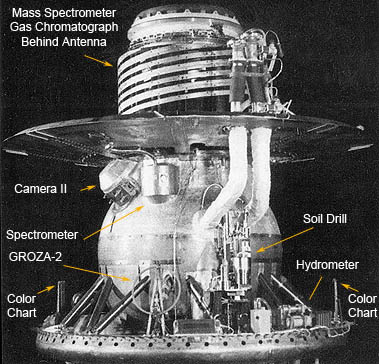 Venera-13 Lander
Venera-13 Lander
|
|
Above left, the 760 kilogram Venera-13 lander is seen during installation in its reentry vehicle. Dark rectangular shutters on the RV are for temperature control during spaceflight.
The two pipes coming out of the side of the lander connect it to the temperature control system of the spacecraft bus. Gas circulating through them enters a heat exchanger inside the sealed pressure hull; and prior to reentry, the lander is pre-cooled to -10° C.
Venera-13's lander was 100 kg heavier than Venera-9's, with increased battery power and more experiments. Many are improvements on experiments installed on Venera-11 and 12, including more accurate versions of the mass spectrometer and gas chromatograph. The Groza-2 now included The thermometers, barometers and nephelometer were helping to build up an accurate model of the atmosphere and cloud structure. 13 Soundings of the atmosphere and clouds by Soviet probes form the bulk of our knowledge today. Measuring the water vapor content of the Venusian atmosphere was particularly important to chemical and thermodynamic models of the planet. Water is needed to form Sulphuric acid in the clouds, and its infrared absorption bands contribute to the greenhouse effect. Humidity measurements by Soviet and American probes varied, sometimes inconsistently, and Russian scientists designed a variety of experiments to answer this question definitively. Iu.A. Surkov designed a series of hydrometers, including the VM-3R on Venera-13 and 14, while V.I. Moroz applied spectroscopy, designing the IOAV devices to include a few important water vapor spectral bands. |
 Venera-13 Lander
Venera-13 Lander
|
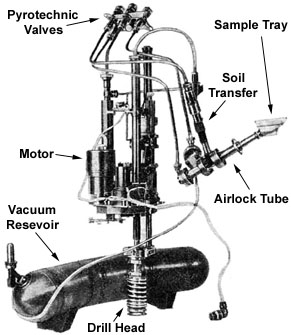 Soil Drill
Soil Drill
|
|
By the time of Venera-13 and 14, a surprising amount of complex equipment was simply installed outside the pressure hull, exposed to the intensely hostile surface conditions. By this time, Soviet engineers had developed new heat-resistant materials and electronics that were comfortable in this working environment.
Exotic lubricants, based on molybdenum disulphide and microscopic metal flakes, were designed to function at high pressures and temperatures up to 1000° C.
While never deployed, a seismometer and thermopile battery were developed and tested, capable of operating indefinitely on the surface of Venus.
Perhaps the most impressive of these high temperature devices was the GZU soil sampling drill. Capable of drilling 3 cm into solid igneous rock, if needs be, it required the invention of new alloys and an electric motor. Machine parts were designed to fit and function properly only after thermal expansion to 500° C. The telescoping drill head lowers to the surface and bores for two minutes. Pyrotechnic charges break a series of seals that allow the high pressure atmosphere of Venus to rush into an assembly of tubes. Soil is carried in stages, into a soil transfer tube and onto a sample container. The sample container is driven through an airlock by pyrotechnic charges and into the x-ray fluorescence chamber. A large vacuum reservoir then lowers the chamber pressure to about 0.06 atmospheres.
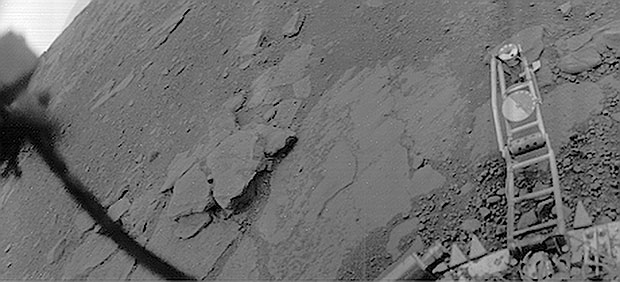
Segment of Venera-13 Clear-Filter Image Venera-13 was launched October 30, 1981 and arrived at Venus on March 1. Once again, orbiting was not energetically feasible, so the main spacecraft bus flew by, relaying telemetry as Venera-11 had done. Its sister ship, Venera-14, was launched on November 4 and arrived on March 5. As on previous missions, a slow parachute descent through the clouds was followed by free fall to the surface. Metal teeth ringing the landing pad were added to aerodynamically stabilize the lander and prevent spinning and oscillations which may have damaged Venera-11 and 12. An impact at 7.5 meters/sec (about 17 mph) and rebound were analyzed by the onboard accelerometer, and scientists later concluded that both crafts landed on hard rock with a crumbly surface. During the descent, improved mass-spectrometer results, gas-chromatography results and cloud aerosol XFS results were gathered, as well as more temperature and pressure soundings, and new measurements of the sky spectrum. An interesting result from mass spectrometry was the abundance of argon-40, a radioactive decay product of potassium. On Venus, the relative abundance of this isotope was about 25 percent of terrestrial values. Radar studies of the planet show no tectonic plates, no continual turnover of the crust as on Earth. Thus volatile radiogenic argon has remained trapped below ground. Venera-13 landed on an undulating landscape, fading at a distance into a haze of dense atmosphere. The rotory penetrometer can be seen extended out to measure physical and electrical soil properties. The exhaust port of the cloud-aerosol XFS analyzer is on the landing ring to its left. |
 Venera-13 Camera and Spectrometer
Venera-13 Camera and Spectrometer
|
 Camera and Pressure Window
Camera and Pressure Window
|
|
A panoramic camera is seen above, during lab testing. A protective cover fits in the cylindrical frame around the pressure window. The metal cylinder to the right of the camera is the insulated housing of the spectrometer. A corrigated metal tube extending from its top contains fiberoptic light pipes from several receivers mounted on the aerobrake.
Both cameras on both landers worked perfectly, producing the best images ever seen of the surface of Venus. With much higher telemetry bandwidth, the cycloramic cameras returned digital images of 252 pixels per vertical scanline, with 9 bits/pixel encoded logarithmically. Unlike typical cameras, each pixel was a photometer reading, on an undistorted spherical projection of about 37° × 180°. Camera design was similar to Venera-9, but included four filters for clear, red, green and blue scans of the surface. The cameras scanned back and forth for the duration of the surface mission, through color or clear filters. |
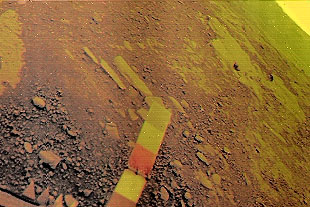 Venera-13 Terrain
Venera-13 Terrain
|
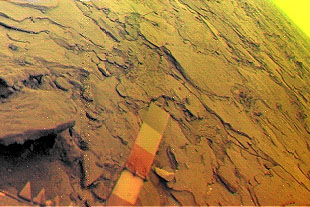 Venera-14 Terrain
Venera-14 Terrain
|
|
Venera-13 revealed rolling hills with layered slabs of rock and soil.
From high resolution radar imaging of the landing site, Russian geologists A.M. Abdrakhimov and A.T. Bazilevskii concluded that Venera-13 probably landed on the most common type of Venusian terrain, plains with wrinkle ridges.
These are the oldest volcanic plains, formed about 750 million years ago, fractured and buckled by tectonic pressures in the crust.
Venera-14 saw a flat expanse of rock with no soil. Radar imaging of the site reveals a younger volcanic plain with lobate flows of lava, probably formed a few million years ago. The rock, which was first considered to be solidified lava, is actually layered and crunchy (as determined by impact deceleration analysis). One new theory suggests it is a pumice-like material, formed out of volcanic ash or dust from meteorite strikes. On Venus, large meteorites generate pulverizing shock waves in the dense atmosphere, even when the meteorite burns up before impact. Radar reveals parabolic fans of airfall deposits, downwind from these impacts and airbursts. The full panoramas from Venera-13 and Venera-14 can be seen here. |
 Enamel colors
Enamel colors
|
 At 500º C and 100 atm
At 500º C and 100 atm
|
 Illuminated by Sky Spectrum
Illuminated by Sky Spectrum
|
|
The yellowish-orange coloring is due to Rayleigh scattering and possibly additional blue-absorbing gases in the deep atmosphere. The zenith sky spectrum was measured during descent and after landing. The color chart unfolded on the surface is painted with heat-resistance silicone enamel. The gray, red, green and blue pigments are color-shifted by pressure and heat (piezochromism and thermochromism) and tinted by the orange illumination of the sky.
The room-temperature and hot/pressurized paint spectra were carefully measured, and sRGB values are displayed above
(one of the builders of the camera has told me that the spectrometer was destroyed in the process of measuring the enamel colors at 500° C and 100 atm).
Precise color balance of the Venera-13 and 14 images has never been calculated with complete satisfaction, in part because the radiometric response of the camera is uncertain.

Venera-13 Microphone Signal Scientists had once speculated that the fast zonal winds of Venus might polish its surface smooth. But compression and conservation of momentum dictate otherwise, and measurements have shown the surface winds are only about 0.5 to 1.0 meter/sec. The atmosphere is very dense at the surface, but unlike a liquid, the viscosity of gas does not increase much with pressure. In a perpetual dead calm, the surface of Venus is almost untouched by wind erosion. The microphone in the Groza-2 device measured the sound of the wind, providing another estimate of its speed. It also captured the sounds of the lander's activity, the explosive ejection of the camera covers, the soil drill, and the explosive charge used to propel the soil sample tray into the x-ray fluorospectrometer.

Blowing Dust and Changing Illumination on Venus Wind speeds were also measured by Doppler radio, cup anemometers (on Venera-9 and 10) and from the observation of fine dust blown by wind. Two images, taken about an hour apart, so the gradual blowing away of soil on the landing ring of Venera-13. Changes in the quality of illumination appear, becoming less diffuse at some times. This is probably due to the movement of clouds, which would probably cause vague regions of lighter and darker sky as seen from the surface. It is believed that the Sun's disk is never visible.
Iurii Surkov's soil analysis experiment worked perfectly on both landers. Once soil had been loaded into the analyzer, X-ray fluorescence excited by radioactive isotopes, was measured by a 128-channel analyzer. Results at the Venera-14 site were similar to the readings from terrestrial ocean-floor basalts. At Venera-13's site, readings indicated a less common (on Earth) form of potassium-rich basalt. |
Biographies
AcknowledgementsMany image are from NASA and come courtesy of their generous non-commercial usage policy. In particular, many are from the web site of David R. Williams, National Space Science Data Center, nssdc.gsfc.nasa.gov. The color pictures of Venera-13 camera are courtesy of Vladimir V. Semenov of VideoCosmos.Special thanks to Aleksander Bazilevskii, Yuri Gektin, Leonid Ksanfomaliti, and Vladimir Kurt for their comments, answer to questions and recollections about these missions. |

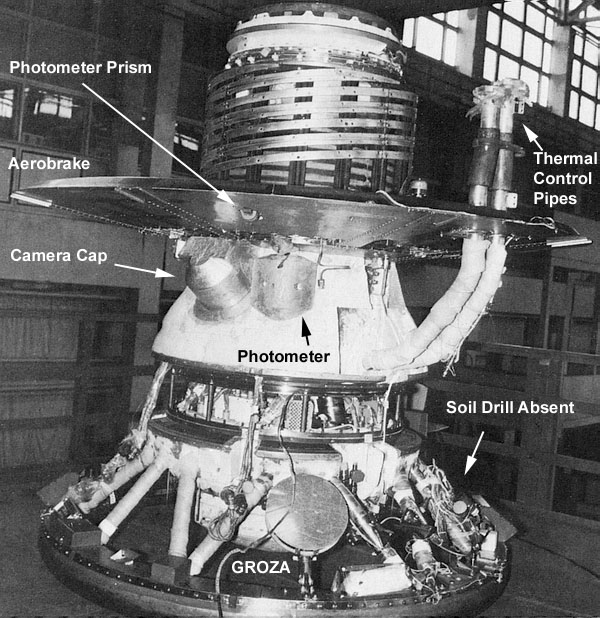
 V.G. Istomin
V.G. Istomin
 L.V. Ksanfomaliti
L.V. Ksanfomaliti
 Iu.A. Surkov
Iu.A. Surkov